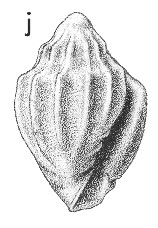
Revised descriptions of New Zealand Cenozoic Mollusca from Beu and Maxwell (1990)

 | Revised descriptions of New Zealand Cenozoic Mollusca from Beu and Maxwell (1990) | 
|
  (Pl. 27j): holotype, GS 1295, Y17/f7474, 3.2 km up Mangarueke Stream [Mangaruaki Str. on Y17] from Waipaoa River, east of Te Karaka, Gisborne, Altonian or Clifdenian (TM 6843, GNS) |
Beu & Maxwell (1990): Chapter 12; p. 246; pl. 27 j.
Synonymy: Marginella (Hiwia) amplificata Marwick 1931, p. 129
Type species of Hiwia Marwick, 1931
Classification: Marginellidae
Description: Small for family (5.1 x 3.3 mm) and very wide, with smoothly rounded apex and prominent, concave sutural ramp. Protoconch and sutures hidden by smooth callus; exterior smooth and glossy except for prominent, narrowly rounded, widely spaced axial costae that commence abruptly as shoulder nodules, extend to lower suture on spire whorls and extend down over most of last whorl. Outer lip thick, bevelled to thin, smooth inner margin. Inner lip not thickened; bearing 4 prominent plaits increasing in obliquity down columella, lowest bordering anterior canal; anterior end of aperture unnotched, weakly thickened.
Comparison: Marwick (1931) compared Hiwia with the Recent tropical American Glabella Swainson, 1840, which differs from Hiwia in having prominent denticles inside the outer lip, and in having a distinct anterior notch, as well as in its much larger size. Coan (1965) and Coovert & Coovert (1995) published revised classifications of the Marginellidae, in both of which Hiwia is regarded as a full genus distinct from Glabella. Hiwia seems to be represented in the southern Australian Late Eocene fauna by Marginella aldingae Tate, 1878, which was referred to Plicaginella Laseron, 1957 by Laseron (1957, p. 285). The type species of Plicaginella, however, has a strong anterior notch, whereas M. aldingae apparently lacks such a notch.
Distribution: Otaian-Tongaporutuan; Te Karaka, Gisborne, Altonian or Clifdenian (type); Northland, Nelson, Westland, many localities in Gisborne district, but not known in Wairarapa district, and nowhere common. A very useful indicator of Miocene bathyal facies.
Cite this publication as: "A.G. Beu and J.I. Raine (2009). Revised
descriptions of New Zealand Cenozoic Mollusca from Beu and Maxwell (1990). GNS
Science miscellaneous series no. 27."
© GNS Science, 2009
ISBN
978-0-478-19705-1
ISSN 1177-2441
(Included with a PDF facsimile file
copy of New Zealand Geological Survey Paleontological Bulletin 58 in CD version
from: Publications Officer, GNS Science, P.O. Box 30368 Lower Hutt, New
Zealand)